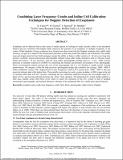| dc.contributor.author | Cahoy, K. | |
| dc.contributor.author | Fischer, D. | |
| dc.contributor.author | Spronck, J. | |
| dc.contributor.author | Demille, D. | |
| dc.date.accessioned | 2017-08-05T15:25:00Z | |
| dc.date.available | 2017-08-05T15:25:00Z | |
| dc.date.issued | 2010 | |
| dc.identifier.issn | 0277-786X | |
| dc.identifier.uri | http://hdl.handle.net/1721.1/110927 | |
| dc.description.abstract | Exoplanets can be detected from a time series of stellar spectra by looking for small, periodic shifts in the absorption features that are consistent with Doppler shifts caused by the presence of an exoplanet, or multiple exoplanets, in the system. While hundreds of large exoplanets have already been discovered with the Doppler technique (also called radial velocity), our goal is to improve the measurement precision so that many Earth-like planets can be detected. The smaller mass and longer period of true Earth analogues require the ability to detect a reflex velocity of ~10 cm/s over long time periods. Currently, typical astronomical spectrographs calibrate using either Iodine absorptive cells or Thorium Argon lamps and achieve ~10 m/s precision, with the most stable spectrographs pushing down to ~2 m/s. High velocity precision is currently achieved at HARPS by controlling the thermal and pressure environment of the spectrograph. These environmental controls increase the cost of the spectrograph, and it is not feasible to simply retrofit existing spectrometers. We propose a fiber-fed high precision spectrograph design that combines the existing ~5000-6000 A Iodine calibration system with a high-precision Laser Frequency Comb (LFC) system from ~6000-7000 A that just meets the redward side of the Iodine lines. The scientific motivation for such a system includes: a 1000 A span in the red is currently achievable with LFC systems, combining the two calibration methods increases the wavelength range by a factor of two, and moving redward decreases the 'noise' from starspots. The proposed LFC system design employs a fiber laser, tunable serial Fabry-Perot cavity filters to match the resolution of the LFC system to that of standard astronomical spectrographs, and terminal ultrasonic vibration of the multimode fiber for a stable point spread function. | en_US |
| dc.language.iso | en_US | en_US |
| dc.publisher | SPIE - The International Society for Optical Engineering | en_US |
| dc.subject | astronomical techniques | en_US |
| dc.subject | Doppler shift | en_US |
| dc.subject | extrasolar planets | en_US |
| dc.subject | Fabry-Perot interferometers | en_US |
| dc.subject | laser beam applications | en_US |
| dc.subject | visible spectrometers | en_US |
| dc.title | Combining laser frequency combs and iodine cell calibration techniques for Doppler detection of exoplanets | en_US |
| dc.type | Article | en_US |
| dc.identifier.citation | Cahoy, K., Fischer, D., Spronck, J., & DeMille, D. (2010). Combining laser frequency combs and iodine cell calibration techniques for Doppler detection of exoplanets. Proceedings Of The SPIE - The International Society For Optical Engineering, 7739(12 pp.). doi:10.1117/12.858202 | en_US |
| dc.contributor.department | Space Telecommunications Astronomy and Radiation (STAR) Lab | |
| dc.contributor.department | Massachusetts Institute of Technology. Department of Aeronautics and Astronautics | |
